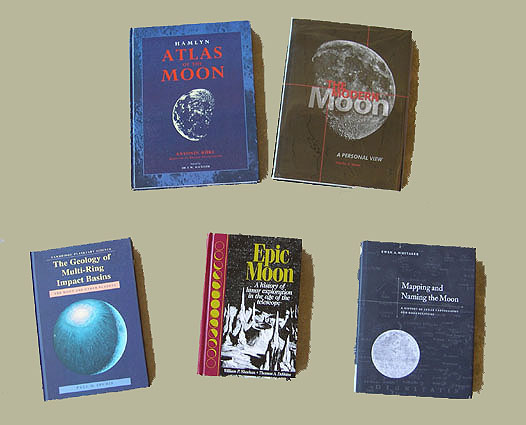Difference between revisions of "September 22, 2004"
| Line 52: | Line 52: | ||
</td></tr> | </td></tr> | ||
</table> | </table> | ||
| − | + | {{wiki/ArticleFooter}} | |
| − | |||
| − | |||
| − | |||
| − | |||
| − | |||
| − | |||
| − | |||
| − | |||
| − | |||
| − | |||
| − | |||
Revision as of 19:05, 1 February 2015
A Perfect Collection of Lunar Books
Image Credit: Chuck Wood |
|
A Perfect Collection of Lunar Books What books do you really need to study and understand the Moon? Here is a minimalist collection, divisible into two parts. First, for observers, you need to know where you are on the Moon, and how to understand what you see. Rukl's Atlas of the Moon is unrivaled - it's an easy choice. Unfortunately, it's virtually impossible to buy. But Sky & Telescope is reportedly nearly finished with a long-awaited revised edition. As for a guidebook to understanding the geology of the Moon - I hope you will excuse my lack of modesty - my book, The Modern Moon - A Personal View is an up-to-date description of the current scientific understanding of our satellite. For armchair explorers of the Moon, perhaps wanting to dig deeper, here are three additional books, recommended because I use them all the time. It is amazing that there had not been a history of the study of the Moon until 2001 when Bill Sheehan and Tom Dobbins published Epic Moon. They tell stories, both familiar and previously unknown, of the great triumphs and sad tragedies of scientists obsessed with observing the Moon. A completely different perspective on lunar history is provided by Ewen Whitaker's Mapping and Naming the Moon. For anyone interested in old maps and the vagaries of naming features on them, Ewen's book is a must-have. The most important features on the Moon are the giant impact basins, and Paul Spudis is the modern master of lunar basins. His The Geology of Multi-Ring Impact Basins is a great technical overview summarizing the geophysics, geochemical, petrologic and geologic evidence for the nature of basins. You may wonder - isn't something missing from this list - and of course the answer is, yes. Don Wilhelms' The Geologic History of the Moon is the foundation for my book and to a degree Paul's, but Don has already had multiple LPODs! Related Links: Yesterday's LPOD: Littrow Rilles - A Wider View Tomorrow's LPOD: Lunar Crater Types |
|
Author & Editor: Technical Consultant: Contacte al Traductor: A service of: |
COMMENTS?
Register, Log in, and join in the comments.




